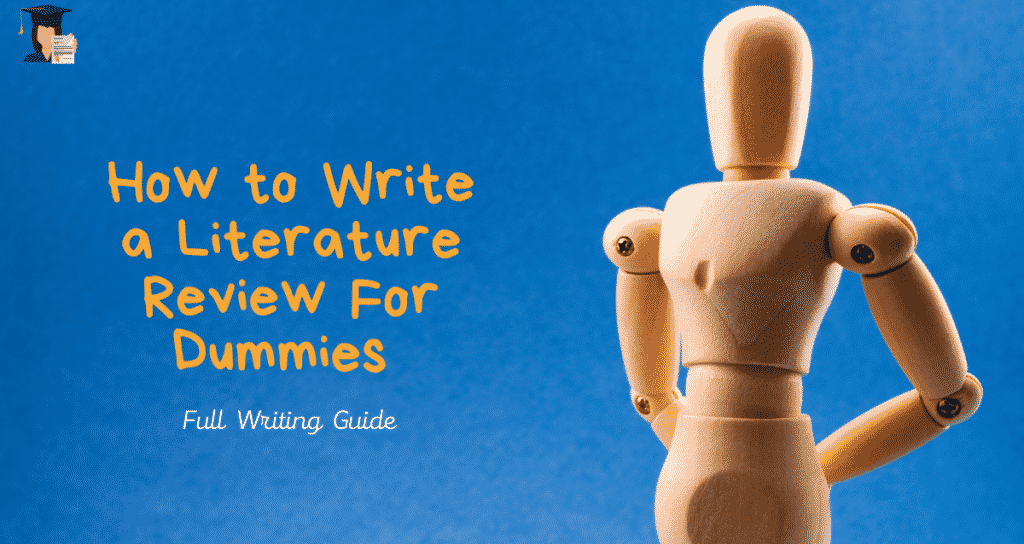Do you want to learn how to write a literature review? First, you have to remember that a literature review forms a part or section of an essay, research project, or dissertation. It is a short but critical analysis of trustworthy opinions, books, articles, research, or other literature. Writing your literature review for the first time can be tormenting especially when you don’t have someone to guide you. If this is you, you have nothing to worry about. In this how to write a literature review for dummies guide, our research paper writing experts have provided all the information you need to get started.
Do not mistake a literature review for an annotated biography, which is a summary of an article you are reviewing. A literature review goes beyond a summary because it focuses on a specific topic that interests you and must include a critical analysis of how the review relates to other works.
If the review is about your graduate paper, you’ll have to apply your methods in the review to make your conclusions. It’s imperative that before your research, you have to look into all the sources on your topic and ensure all the relevant information you get is included in your review.
What’s the Need for a Literature Review?
As a student, you might underestimate the importance of a literature review. One of the most important things about a literature review is, it is a requirement for your graduation. It will show your professor your awareness and knowledge of the topic. The professor will look at the various sources you’ve used in your literature review to evaluate your work and understanding. To demonstrate your knowledge of the topic, you must write a detailed and good research paper.
The Purpose of a Literature Review
The primary purpose of a literature review is to critically analyze content that covers the existing evidence, theories, and research of the topic. The second purpose is that it allows you to provide your critical discussion and evaluation of the content.
To ensure your literature review meets its purpose, you must start by identifying the key areas before your research. You can do this by first understanding the topic, then brainstorming on what should be included. It will help you come up with relevant sources for your research work.
You’ll have to describe all your sources and explain how they contribute to understanding the topic or a specific issue within your work.
Your literature review should be able to reveal all the major points that bring controversies. Once you highlight these areas, you should be able to give your own opinion persuasively and convincingly. To do this, you must interpret any data you have, shed light on the gaps in previous research works, and explain how your research will or is filling these gaps. You have to describe how the sources relate to each other and how they contribute to your entire research. Your sources must be reliable, trustworthy, and up-to-date. Since your research will not cover all the gaps in the topic, you need to show the way forward for further research on the topic. You can even suggest the areas you feel need further work.
Types of Literature Reviews
To know how to write a literature review, you must understand the different literature review types. The following types of literature reviews are the most common in the academic world.
Argumentative Review
Just as the name implies, an argumentative literature review selectively examines the literature to refute or support a philosophical problem, deeply rooted assumptions, or established arguments in the field you are working on. An argumentative review develops a body of literature that supports a contrary point of view from what is already established.
Integrative Review
An integrative literature review synthesizes secondary data of a research topic to generate new perspectives and frameworks on the topic. If your literature review doesn’t involve any primary data collection and analysis, an integrative literature review will be the only option for you.
Historical Review
When writing a historical literature review, your focus should be on existing research for a particular period. In most cases, you’ll be required to start from the first time a phenomenon, theory, concept, or issue emerges, then trace its evolution up to a given point in time, which can even be the present time. Historical literature review puts research into a historical context.
Methodological Review
The methodological literature review focuses more on how someone came about to say what they said. The reviewing method used here provides a framework that can help understand the topic at different levels. Generally, a methodological literature review summarizes a methodological issue then provides the best-practice recommendations.
Systematic Review
A systematic review requires a well-defined and more rigorous approach than other types of literature reviews. This literature review is very comprehensive and provides the details of the timeframe within which the review was selected. There are two categories of systematic literature review: meta-synthesis and meta-analysis. Meta-synthesis is based on non-statistical techniques, while meta-analysis uses standardized statistical procedures.
Theoretical Review
A theoretical review focuses on all theories regarding a phenomenon, theory, concept, or idea. It plays a significant role in establishing the relationships between theories that still exist and examines what extent these theories have been investigated. The theoretical review also develops new hypotheses for testing.
How Long Should a Literature Review Be ?
Generally, a literature review should make up between 15% to 30% of your research paper, though some professors recommend 10% to 20%. For a thesis, it means your literature review should be about 6,000 to 12,000 words long. The actual number of words will depend on the length of your research paper, the field of study, and your tutor’s instructions.
Literature Review Format Styles
There are three types of literature review format styles; these include:
APA
When using APA format, type your review on a standard size, 8.5″ x 11″ paper. Leave a margin of 1″ on all sides. APA recommends that you use 12 pt. Times New Roman font.
The paper should be double-spaced throughout, including all quotes, the title page, notes, and references pages. The title page carries page number 1.
MLA
Use a legible font that allows a clear distinction between italic and regular letters. Time New Roman is a good option unless the tutor specifies otherwise. Leave a margin of 1″ all around the paper. The recommended font size is 12 pt. All text in the review paper should be double-spaced, and the first line of every paragraph should be indented 1/2″. Begin numbering from 2 on the second page.
Chicago
There’s no recommended font or font size in Chicago format, but you must choose something readable and simple, like 12 pt. New Time Roman. The margins should not be less than 1″, and all paragraphs must begin with a 1/2-inch indent. The body text of the review should be double spaced. Use left-justified text. Page numbers should be 1″ from the edge of the page.
Components/Structure of a Literature Review
Below are the components of a literature review:
Introduction
The introduction is where you state the theme of your work, then go ahead and justify the need to review the literature. You can use it to hook the reader to your literature review and provide the scope of your review. That is, use the introduction to state the particular aspect of your research area. Your introduction should be short but concise. It should connect the reader to the body of your review.
Body Paragraphs
The body of the review is where you present your arguments. It can contain many paragraphs, with each paragraph dedicated to a particular point. The body paragraphs should flow easily from one to the next . You can structure them chronologically, thematically, or methodically.
You don’t need to use too many words in the body paragraphs. Each sentence should add value to your argument. That’s why you need to summarize and synthesize the points, analyzing and interpreting them. Also, remember you must also critically evaluate each point to tie it to the topic.
Conclusion
The conclusion is an essential part of your literature review. You can use it to summarize your main ideas to remind the reader about what you’ve just discussed. You can also use it to mention the gaps in your research and recommend further research on the topic. The conclusion also provides you with a platform to air your final views about the topic.
The Writing Process of a Literature Review
Let’s look at how to write a literature review for dummies. To get a good literature review, follow the steps below:
Identify the topic
If you are not provided with a topic, you’ll need to pick one on your own. Choosing a topic on your own is advantageous because you’ll have the freedom to choose the topic you resonate with the most. A good topic should be catchy and relevant to your field of study. Also, make sure the topic you choose has many sources of information for your research.
Conducting research
Once you’ve settled on a topic, the next step is to conduct your research. First, you must come up with a list of keywords that will help with your research. You can then start your research, making sure you pick only the relevant research materials.
Asses and prioritizing sources
There are many sources of information out there, but not all of them are reliable. For your research, you need sources that are current, relevant, and credible. You can use books, government publications, peer-reviewed papers, or reputable websites.
Identify relationships, key ideas, and Gaps
As you read the information from your sources, you’ll be able to identify how they relate. You’ll also be able to pick the key ideas mentioned in the sources. It will help you choose the most important points to include in your review. You’ll also be able to identify gaps that your research can fill. If you can’t fill all the gaps, you’ll recommend further research to cover the remaining ones.
Make an outline
Before you start writing your literature review, you must first come up with an outline. The outline will not only help structure your review but will also help you arrange your points logically. The outline can also help you distribute words to each section of the review.
Write
You now have all the information you need, plus the outline. You can now go ahead and write your review. While writing, make sure you follow the format recommended by your tutor (APA, MLA, or Chicago).
Edit and proofread
After writing your literature review, take your time to edit and proofread it before submitting it. This process is necessary to eliminate both typographical and grammatical errors. There are many online tools that you can use to edit your review and check for errors. You can as well give your friend the review to proofread and edit it for you.
Tips on How to Write a Perfect Literature Review
When writing your literature review, keep the following issues in mind:
Use Evidence
You must use evidence to back the way you interpret your sources that you believe validate your argument. You can use citations.
Be Selective
From your sources, select only the ones that advance your argument. The information you choose should relate to your research problem and contribute to advancing your stance.
Use Quotes carefully
Quotes are necessary for emphasizing points, but you need to use them sparingly. Your review should not have too many quotes that might end up interfering with its readability. Also, make sure you pick only quotes from credible sources or people.
Keep Your Own Voice
Your literature review should sound natural. It should sound like the ideas are coming from you and not copied from other people. Even if referring to your sources, try to maintain your voice. You can do this by starting and ending paragraphs with your wording and ideas.
Use Caution When Paraphrasing
When you paraphrase a source that’s not your own, make sure you don’t twist the author’s opinions and information. When paraphrasing, the message must remain the same, but in different words. Also, remember to cite the source of information.
Use Models
Using models will ensure your literature review sounds authentic. Models add weight to your arguments.
Consider Whether Your Sources are Current
Before you include a source of information in your literature review, check the source’s date/year of publication; otherwise, you might find yourself dealing with outdated information.
You have successfully completed reading the how to write literature review for dummies guide. Now you can go and get started with your writing. Good luck! Keep these tips in mind to guide you and you will be writing great literature reviews in no time!
When is the best time to do a literature review?
Whether you are dealing with a quantitative or qualitative research/study, or just a literature review, the review should be written before the study, during the study, and even at the end of the study, analysis, and report writing. A literature review is a continuous process.
Can a source be included in a literature review?
Yes. The sources you should include are peer-reviewed conference papers, dissertations, books, articles, etc. Include major works and studies in the field. Focus on both primary and secondary sources of information.
What are the steps in writing a literature review?
The steps involved in writing a literature review include identifying the topic, conducting research, assessing and prioritizing sources, making and outlining, and finally writing the literature reviews. After writing it, you must edit and proofread it before submission.



